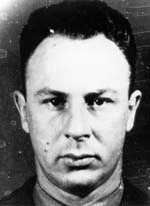b. 14/05/1921 Chicago, Illinois. d. 02/12/1950 Yudan-ni, Korea.
DATE OF MOH ACTION: 01/12/1950 Yudam-ni, Korea.
William Windrich was born on May 14, 1921, in Chicago, Illinois. He attended public schools in Hammond, Indiana. He enlisted at seventeen in the Marine Corps Reserve on June 6, 1938, and was ordered to active duty in November 1940. During World War II, he spent 20 months overseas in the South and Central Pacific as a machine gunner with the 2nd and 5th Defense Battalions and was on Tarawa. Discharged in November 1945, he reenlisted in the regular Marine Corps the following February.
In the summer of 1946, he participated in the atomic bomb tests at Bikini Atoll while serving aboard the USS Mount McKinley. After World War II, he served as a non-commissioned officer of the guard in Washington, D.C., at the Naval Gun Factory and at Marine Corps Headquarters, and in China.
Staff Sergeant Windrich was killed in action the early morning of December 2, 1950 near Yudam-ni, North Korea, during a savage night battle with Chinese forces on Hill 1520. He had refused to be evacuated after being wounded twice, once when a grenade fragment ripped through his helmet. Later felled by gunshot wounds in the legs, he directed his men in setting up defensive positions and shouted words of encouragement until he succumbed to his wounds and the bitter cold. He was carried down from the hill and was buried. He is now buried at Arlington National Cemetery in Arlington, Virginia.
The Medal of Honor, the United States’ highest award for valor in combat, was presented to his widow by Secretary of the Navy Daniel A. Kimball during ceremonies on February 8, 1952, in Washington, D.C.
MOH CITATION:
For conspicuous gallantry and intrepidity at the risk of his life above and beyond the call of duty as a platoon sergeant of Company I, in action against enemy aggressor forces the night of 1 December 1950. Promptly organizing a squad of men when the enemy launched a sudden, vicious counterattack against the forward elements of his company’s position, rendering it untenable, S/Sgt. Windrich, armed with a carbine, spearheaded the assault to the top of the knoll immediately confronting the overwhelming forces and, under shattering hostile automatic-weapons, mortar, and grenade fire, directed effective fire to hold back the attackers and cover the withdrawal of our troops to commanding ground. With seven of his men struck down during the furious action and himself wounded in the head by a bursting grenade, he made his way to his company’s position and, organizing a small group of volunteers, returned with them to evacuate the wounded and dying from the frozen hillside, staunchly refusing medical attention himself. Immediately redeploying the remainder of his troops, S/Sgt. Windrich placed them on the left flank of the defensive sector before the enemy again attacked in force. Wounded in the leg during the bitter fight that followed, he bravely fought on with his men, shouting words of encouragement and directing their fire until the attack was repelled. Refusing evacuation although unable to stand, he still continued to direct his platoon in setting up defensive positions until weakened by the bitter cold, excessive loss of blood, and severe pain, he lapsed into unconsciousness and died. His valiant leadership, fortitude, and courageous fighting spirit against tremendous odds served to inspire others to heroic endeavor in holding the objective and reflect the highest credit upon S/Sgt. Windrich and the U.S. Naval Service. He gallantly gave his life for his country.
BURIAL LOCATION: ARLINGTON NATIONAL CEMETERY, ARLINGTON, VIRGINIA.
SECTION 31, GRAVE 4856
LOCATION OF MEDAL: FAMILY.

